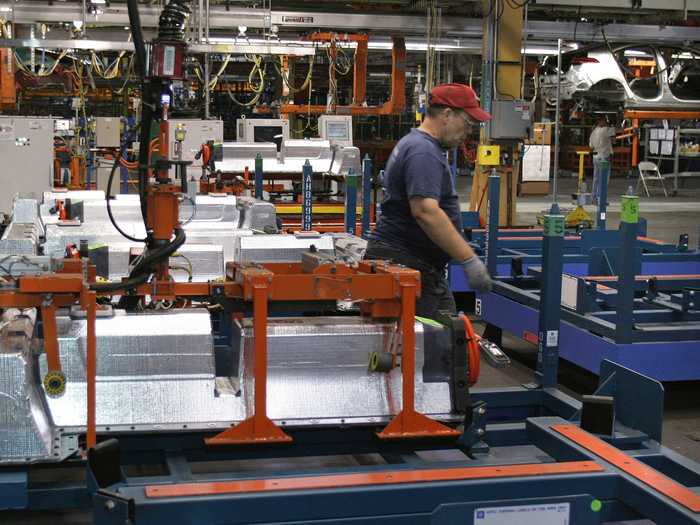
Number employed in 2012: 268,400
Number projected in 2022: 211,100
Percent decline: 21.3%
Why: The recent recession put a ton of pressure on this industry, which manufactures products such as artificial flowers, mirrors, umbrellas, and fly swatters. These items mostly fall into consumer discretionary spending, which sank during the recession and remains low as the recovery inches along.

Number employed in 2012: 234,600
Number projected in 2022: 183,100
Percent decline: 21.8%
Why: U.S. textile mills began to close decades ago, and that trend hasn't reversed. It's much cheaper for companies to outsource textile production to other countries than to pay employees at home.

Number employed in 2012: 25,000
Number projected in 2022: 19,400
Percent decline: 22.4%
Why: Hardware products are typically used in the manufacturing of other items like cars and furniture. Demand for those products collapsed during the recession, and the hardware industry still hasn't recovered, especially with an influx of competitively priced imports.

Number employed in 2012: 451,800
Number projected in 2022: 346,800
Percent decline: 23.2%
Why: E-books, smartphones, tablets, computers, and the Internet are destroying print media. Publishers and editors alike are trying to figure out how to get consumers to pay for content they can find for free online.

Number employed in 2012: 41,600
Number projected in 2022: 31,300
Percent decline: 24.8%
Why: This industry was another one that suffered in the recession. Factories closed and jobs were slashed or moved to cheaper facilities abroad. Plunging domestic auto manufacturing and homebuilding didn't help, either, as overall market demand sank.

Number employed in 2012: 158,600
Number projected in 2022: 118,700
Percent decline: 25.2%
Why: Like so many other manufacturing sectors, companies in this industry continue to move jobs and plants overseas. High-end products are still made in the U.S., but the bulk of cheap and mass-produced items have moved away from home.

Number employed in 2012: 611,200
Number projected in 2022: 442,100
Percent decline: 27.7%
Why: The Postal Service has struggled ever since email caught on. The USPS is hoping that cost-cutting measures and growth in e-commerce deliveries will bolster its revenues, but that largely remains to be seen.

Number employed in 2012: 109,500
Number projected in 2022: 78,600
Percent decline: 28.2%
Why: Product innovation and design still takes place in the U.S., but the actual production of this equipment (TVs, radios, cell phones, etc.) is typically outsourced to countries with lower wages such as Mexico and China.

Number employed in 2012: 29,400
Number projected in 2022: 18,500
Percent decline: 37.1%
Why: Most of the world's consumers of leather and hides are located overseas, which makes for an extremely weak domestic market. U.S. tanners and leather makers depend on the ability to export their products and the trade agreements governing the practice.

Number employed in 2012: 148,100
Number projected in 2022: 62,300
Percent decline: 57.9%
Why: Last time you checked the label, how many of your clothes were made in the U.S.? Similar to textile production, most of apparel manufacturing now takes place overseas. That helps companies cut costs and keep garments cheap for consumers.

 A couple accidentally shipped their cat in an Amazon return package. It arrived safely 6 days later, hundreds of miles away.
A couple accidentally shipped their cat in an Amazon return package. It arrived safely 6 days later, hundreds of miles away. A centenarian who starts her day with gentle exercise and loves walks shares 5 longevity tips, including staying single
A centenarian who starts her day with gentle exercise and loves walks shares 5 longevity tips, including staying single  2 states where home prices are falling because there are too many houses and not enough buyers
2 states where home prices are falling because there are too many houses and not enough buyers "To sit and talk in the box...!" Kohli's message to critics as RCB wrecks GT in IPL Match 45
"To sit and talk in the box...!" Kohli's message to critics as RCB wrecks GT in IPL Match 45
 7 Nutritious and flavourful tiffin ideas to pack for school
7 Nutritious and flavourful tiffin ideas to pack for school
 India's e-commerce market set to skyrocket as the country's digital economy surges to USD 1 Trillion by 2030
India's e-commerce market set to skyrocket as the country's digital economy surges to USD 1 Trillion by 2030

Copyright © 2024. Times Internet Limited. All rights reserved.For reprint rights. Times Syndication Service.